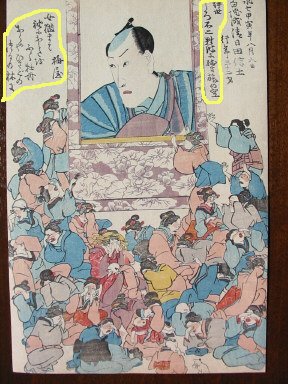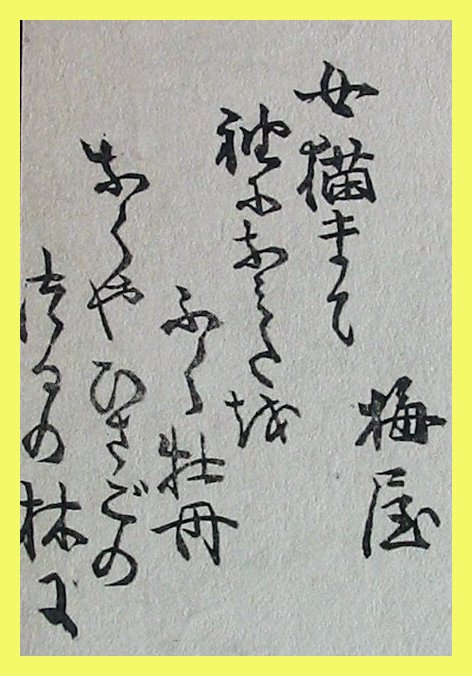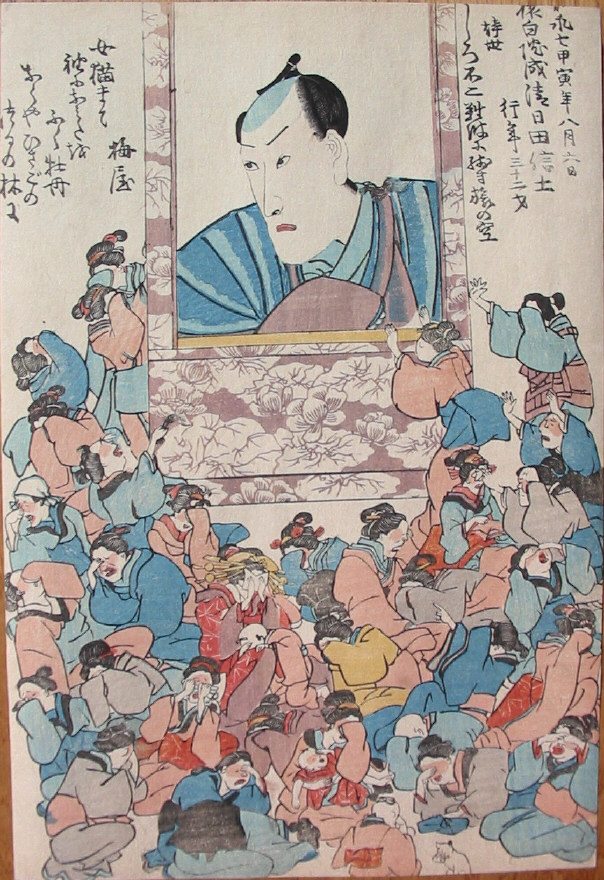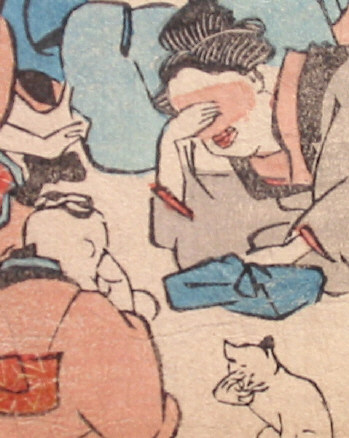 |
JAPANESE PRINTS
A MILLION QUESTIONS
TWO MILLION MYSTERIES
Ukiyo-e Prints浮世絵版画 |
|
Port Townsend, Washington |
|
Possibly By |
|
UTAGAWA KUNIYOSHI |
|
歌川国芳 |
|
うたがわくによし |
|
1797-1861 |
|
Memorial print to Ichikawa Danjūrō VIII |
|
八世代市川団十郎 |
| ばちせだいちかわだんじゅうろう |
|
Unsigned |
|
13 7/8" x 9 3/8" |
|
Ca. 1855 |
| Publisher: Unknown |
| 版元名: 未詳 |
| はんもとな: みしょう |
|
Print Type: shini-e 死絵 |
|
しにえ |
|
Illustrated 1. Catalogue of Japanese Art in The National Gallery, Prague, p. 175, #1046 (listed as anonymous) 2. The Male Journey in Japanese Prints, by Roger Keyes, University of California Press, 1989, p. 184 (Listed as Anonymous) 3. Utagawa Kuniyoshi giga ten (An exhibition of Comic Pictures by Utagawa Kuniyoshi), #34, 1987 (Listed as Authentic) 歌川国芳戯画展 |
|
SOLD! THANKS! |
|
|
|
I think it was an inside joke which Kuniyoshi's audience would have gotten. |
|
|
|
Last October 19th a fellow named Stephen wrote to draw my attention to the fact that there is an irony about a crying cat being portrayed in a memorial print which has an obvious Buddhist connection. (Today is March 5, 2007.) Before his e-mail I hadn't even thought about the cat as being anything other than an artistic device. But Stephen noted that according to some legends the cat was the only creature which failed to mourn the death of the historic Buddha. This is confirmed by Robert Schaap in his catalogue entry #47 to Heroes and Ghosts: Japanese Prints by Kuniyoshi 1797-1861 (Hotei Publishing, Leiden, 1998, p. 72):
"Despite Kuniyoshi's love of cats, these creatures invariably play a very negative role in Japanese ghost stories. One reason that cats may have been held in such low esteem might be that in some versions recounting the death of the Buddha, they appear as the only animal not to weep."
That is what I am sure prompted Stephen's astute statement: "I think it was an inside joke which Kuniyoshis [sic] audience would have gotten." Thanks Stephen!
[See the sections below for further comments on this and a detailed close up of the despairing feline.] |
|
|
|
|
|
FRESH THOUGHTS ABOUT AN OLD SUICIDE (POSTED JULY 12,2005) |
|
|
|
Many misconceptions grow up about the death of idols. Rarely do we know the truth or what passes for it. Even those closest to the deceased are often deluded and can be regarded as being just as accurate as the witnesses to a crime or accident. Generally no two accounts are exactly the same let alone correct. Normally they only give us an approximation of 'the truth'. However, therein lies the job of the great detective/historian. What we know now may not be the same as what we know in the future. Such is the case regarding our knowledge of the death of Danjuro VIII. Forget what you have already read --- or at least set it aside for comparison with what we know now.
I. Danjūrō did not slit his wrists or commit seppuku as it is pictured in certain contemporary prints. In fact, he cut his own throat. Seppuku might have been more honorable in the thinking of the times, but that is not how it happened.
II. He committed suicide on the morning of the opening of a new play he was to act in in Osaka and not several days later as has been reported.
III. His extremely lavish lifestyle may have caused him financial strains, but most likely was not the last straw which caused his death. On the other hand, the complex relationship between him and his father may have been more relevant. Also, there is a distinct possibility that he was a manic-depressive or bi-polar personality. Now, I know, there is a risk of going too far in psychoanalyzing someone who committed suicide more than a hundred fifty years ago, but new scholarship seems to be pointing in that direction. |
|
|
|
NEW INFORMATION PROVIDED ON MEMORIAL PRINTS ADDED ON JUNE 17, 2005 |
|
|
|
In an e-mail correspondence I had in late May 2005 with an expert on Japanese theater and language I was informed that it was generally a standard practice for shini-e, memorial death prints, to omit the names of the artists who created them or the publishers who released them. That would explain why so many shini-e are unattributed. He added that "There are just occasional exceptions to this rule." The print shown on this page lacks both an artist's signature and publisher's mark. However, in the e-mail it was pointed out that "Experts are able to determine artists [and] artists' studios by visual evidence--quirks in portraiture, the presence of a cat, etc." Perhaps that explains the frequent assignation of this print to Kuniyoshi in Japanese books and catalogues. On the other hand, what would appear most commonly on such prints were the actor's most recent stage name along with his posthumous Buddhist name or hōmyō (法名 or ほうみょう) and sometimes his poetic name. This really explains a great deal about this unusual category of ukiyo-e. At least, for me it does. |
|
When Rudolph Valentino died women went crazy. To say that they were hysterical is an understatement. 100,000 people showed up outside of the funeral home. Up to 13 women were said to have committed suicide. He was 31 years old, gorgeous --- to some, a heart throb and he was gone! Dead as a doornail.
Ichikawa Danjūrō VIII (1823-54) committed suicide at the age of 31.* His acting career started the year he was born. He was so precocious that at the age of 9 he was designated head of the family acting troupe. Edo “treated him as its pet… He was extremely handsome and was worshipped by female fans.” In one role he was immersed in a barrel of water.** The water was later sold at enormous profit to frenzied followers. Bakeries increased their sales by naming buns after one of his roles.
His light burned brighter and faster than that of any of his contemporaries. However his personal demons tormented him. He lived far beyond his means. In Osaka (大阪 or おおさか) in 1854 a few days after a successful opening he was found dead with both wrists slashed. The grief was palpable. Notice the weeping women and babies - assuredly female. Even the female cat at the bottom of the print is crying.
After his death Danjūrō was given a posthumous Buddhist name or hōmyō (法名 or ほうみょう). I believe that in Japanese it is 猿白院成清日田信士. (As yet I am unable to give the English transliteration.) |
|
|
|
* The determination of a person's age is cultural and differed between East and West. The text to the right of the hanging scroll indicates that Danjūrō VIII was 32 (三十二) at the time of his death. I am only speculating, but this might be due to the fact that traditionally a child was counted as one year old on the day of its birth. The child would then turn two on New Year's Day even if that were just a few days, weeks or month after the birth date. (I must add one caveat: I have always had problems determining a person's age by simply looking at their bracketed numbers.) This same text also makes a reference to the actor's posthumous Buddhist name. **New Kabuki Encyclopedia, Samuel Leiter, Greenwood Press, 1997, pp. 186. |
|
|
|
|
|
|
The text notes that even the female cats were crying. |
|
| We found a transcription of the text but as yet have not translated it. However we are presenting it to you here as clearly as possible so you can try to follow the flow of the passages yourself. Below we have outlined the areas in yellow which we are featuring as clearly as possible for your own consideration. | ||||||||||
 |
||||||||||
 |
つるの林に |
なくやひさごの
|
く牡丹 |
袖になみたをふ |
女猫まて |
梅 屋
|
|
 |
う しろ不二難波に残す旅の空 |
辞 世 |
|
|
||||||||||
|
|
||||||||||
|
|
||||||||||
|
|
||||||||||
|
|
||||||||||
|
|
||||||||||
| Text above from the left side of the memorial portrait. | Text above from the right side of the portrait. |
|
||||||||
|
Shini-e |
| 死絵 |
| しにえ |
|
According to Samuel Leiter in his New Kabuki Encyclopedia (p. 580, 1997 edition) "death prints" of popular actors appeared soon after their passing. these prints would usually record the actor's "Buddhist name, his age at death, the month and day of his demise, the temple at which he was buried, his death poem, etc."
John Fiorillo provides what may be the finest and most cogent commentary on shini-e in English. He notes, among other things, the common occurrence of the light blue court robe or 'shini sōzoku' worn by the figure being memorialized. He even provides surprisingly specific information about the shini-e connected to the death of Danjuro VIII, the subject of the print seen above.
"The most remarkable production of 'shini-e' occurred with the shocking suicide of Ichikawa Danjûrô VIII (1823 - 1854) in Osaka on August 8, 1854. As many as 200 'shini-e' were produced in reaction to the widespread grief over his death." |
| Shini Sōzoku |
| 死に装束 |
| しにしょうぞく |
| This is a Light blue court robe worn for burial or by those committing suicide. |
|
|
| I would urge anyone interested in Japanese prints and culture and unfamiliar with John Fiorillo's web site at www.viewingjapaneseprints.net/index.html to make it one of their favorite stops. Bookmark and visit it often. You won't be disappointed. |
|
The specific link to his shini-e page is http://www.viewingjapaneseprints.net/texts/topictexts/artist_varia_topics/shini_e3.html |
 HOME
HOME |

